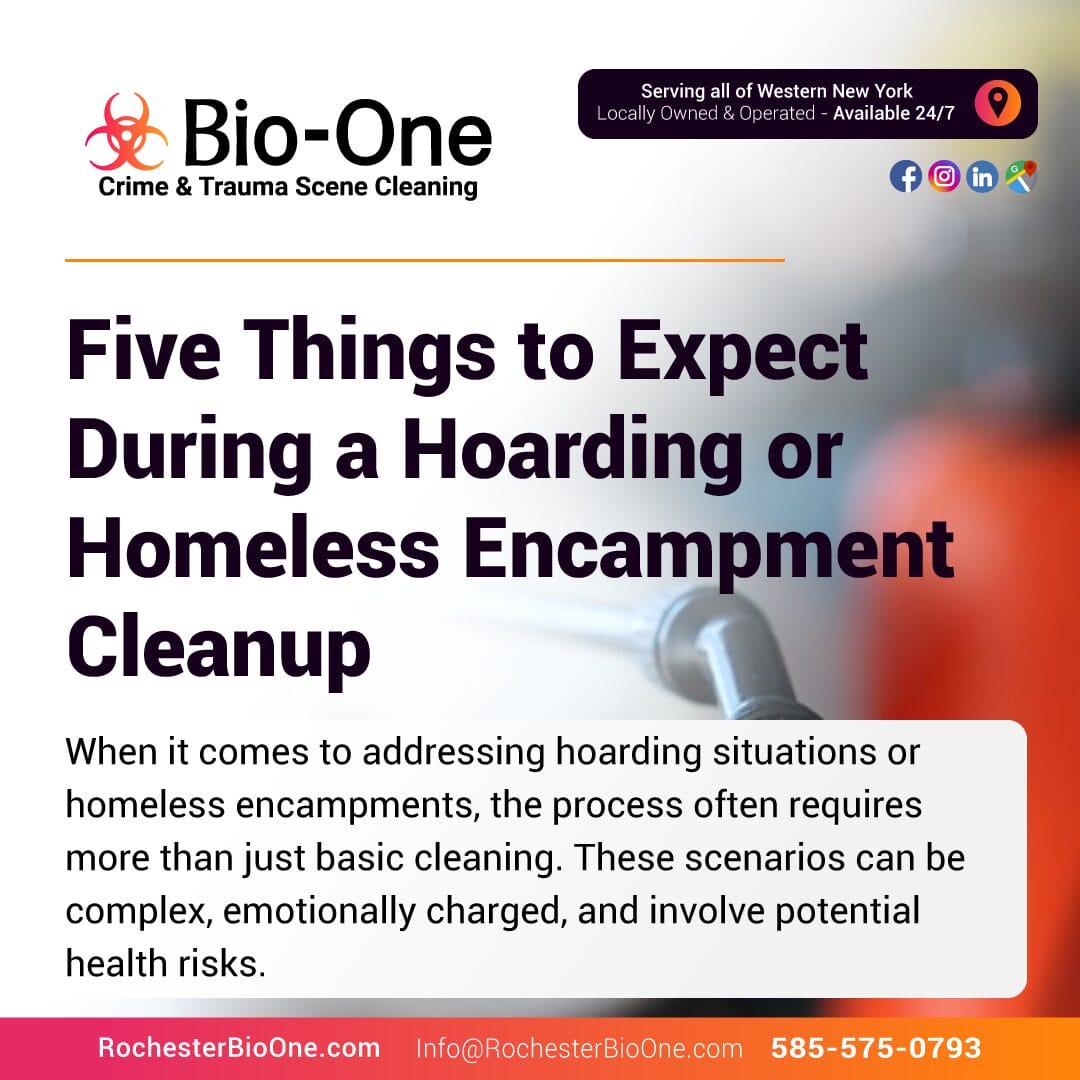
When it comes to addressing hoarding situations or homeless encampments, the process often requires more than just basic cleaning. These scenarios can be complex, emotionally charged, and involve potential health risks. Choosing a company that specializes in compassionate cleanup services ensures the job is handled with professionalism, safety, and care for everyone involved. Here are five things you can expect during a hoarding or homeless encampment cleanup and how Bio-One of Rochester provides support through every step.
Every cleanup process starts with a detailed assessment. Professionals will evaluate the site to determine the extent of the cleanup needed, identify hazards, and create a customized action plan. Common considerations include biohazards, pests, and unsafe structural conditions.
With Bio-One of Rochester , our focus on compassionate cleanup means we also take the emotional impact into account. For hoarding situations, this might involve conversations with the individuals involved or family members to understand their unique needs and concerns.
Hoarding environments and homeless encampments often pose serious safety risks, including the presence of:
Professional cleanup teams prioritize the health and safety of everyone involved by using personal protective equipment (PPE), following biohazard protocols, and incorporating appropriate containment methods. Our compassionate cleanup approach means we follow strict safety measures while respecting the dignity and privacy of individuals in these environments.
In hoarding scenarios, uncovering valuable or sentimental items is a critical part of the process. Bio-One’s team is trained to handle these situations with care. While it’s often necessary to discard damaged or hazardous items, particular attention is paid to saving photographs, documents, and keepsakes whenever possible.
For homeless encampments, the process may involve securing personal items for individuals or coordinating with local support services to ensure displaced individuals are treated with humanity and empathy.
Professional compassionate cleanup requires more than just removing visible debris. It also involves deep cleaning and sanitization to eliminate bacteria, odors, and other contaminants. Depending on the situation, this might include using industrial-strength disinfectants, odor neutralizers, and specialized equipment like ozone generators to restore the space to a habitable condition.
Bio-One of Rochester has the training and tools necessary to not only clean extensively but also to ensure that every step meets environmental and safety standards.
Once the cleanup is complete, the goal shifts to restoring the space so it is usable, safe, and welcoming again. Beyond the physical work, Bio-One provides compassionate guidance to individuals and families during a difficult transition. Our team can connect clients with local resources or offer ongoing support to help maintain a safe and organized environment after the cleanup.
For homeless encampment cleanups, we work closely with communities and local agencies to ensure that the process is carried out respectfully, balancing sanitation needs with sensitivity to those affected.
At Bio-One of Rochester, we are more than a cleanup service—we are a partner in helping individuals and communities move forward. Our emphasis on compassionate cleanup means that we approach every situation with professionalism, respect, and care. Whether you’re addressing a hoarding situation or managing the challenges of a homeless encampment, we provide discreet and thorough services to make the process as smooth as possible.
Bio-One is always ready to react to unanticipated events like death, major accidents, and hazardous situations. In the following areas of New York we provide cleaning and restoration services:
Bio-One is the finest choice for assisting victims and their families if a suicide, homicide, unattended death, crime scene, or traumatic situation occurs. In addition to emergency services, Bio-One, a locally-owned company, also offers biohazard cleanup services for commercial and residential properties.
We understand that biohazardous material can be a great source of stress for property owners, so we work quickly and efficiently to minimize the disruption it causes.
We collaborate with local law enforcement, neighborhoods, emergency services personnel, victim support organizations, hoarding task forces, apartment complexes, insurance company carriers, and others to provide the best service possible.
Our sewage backup cleaning service is available for you or anyone you knows needs it. We have the expertise and equipment to remove and safely dispose of any clutter, debris, and garbage from your home or office. Give us a call at 585-575-0793.

While seemingly different, hoarding and collecting share a common thread when left unchecked: the potential to grow beyond our control, impacting our wallets and our well-being. Whether you're a passionate collector of memorabilia or someone struggling with a condition, the hidden costs of hoarding can carry significant financial and emotional weight. Understanding these effects and finding ways to address them can help restore a sense of balance and harmony to your life.
The financial impact of hoarding and excessive collecting can be much larger than many realize. Here’s why keeping too much stuff can hit your wallet hard:
When collections or hoarded items outgrow the available space at home, many people turn to storage units. While this may seem like a temporary fix, storage fees can quickly add up. According to industry estimates, the average storage unit ranges between $70 and $200 per month, and if the items stay there for years, the total cost can exceed thousands of dollars.
Hoarding often puts immense pressure on a home. Piles of items can block air vents, overload floors, and even pose fire hazards, leading to costly repairs. Mold and pest infestations, common in hoarded homes, require professional decontamination services, further increasing expenses.
A cluttered or hoarded house often brings down property value. If you're planning to sell your home, a cluttered appearance can deter buyers, and excessive damage from hoarding might make the home unmarketable without significant renovations.
For collectors, the thrill of the hunt can lead to impulse buying. Without clear boundaries, collectors find themselves purchasing duplicate items or things they don’t truly need, often spending beyond their means. Over time, these small purchases add up, draining bank accounts and contributing to financial stress.
A cluttered lifestyle often obscures valuable possessions. Many hoarders unknowingly buy replacements for items they already own, simply because they can’t locate them amidst the chaos. Over time, the money spent on these duplicates becomes another hidden cost.
Hoarding and excessive collecting don’t just take a toll on your finances; they also affect mental and emotional health. Below are common emotional costs:
Living in a clutter-filled environment can be overwhelming. The sheer volume of possessions creates visual chaos, which has been linked to increased cortisol levels, the stress hormone. Collectors may experience anxiety about maintaining their items, while hoarders often feel trapped by their belongings.
Excessive hoarding or obsessive collecting can create tension with family and friends. Loved ones may struggle with limited living space, embarrassment, or frustration over unresolved clutter. For some, conflicts about possessions can lead to broken relationships or isolation.
Hoarding has strong ties to mental health conditions like depression. The inability to part with items can contribute to feelings of failure, shame, or hopelessness. Over time, these emotions may lead to isolation, as individuals withdraw from social activities or relationships to avoid judgment.
Hoarders often struggle with extreme emotional attachment to items, making it difficult or impossible to discard anything. Collectors can experience a similar guilt when they feel they’ve neglected or abandoned pieces of their collection, turning their hobby into a source of distress.
For both hoarders and collectors, it’s important to seek help if their behaviors become disruptive or detrimental to their daily lives. Here are some steps that can be taken to address and manage hoarding tendencies:
Bio-One of Rochester is a professional hoarding cleanup and remediation company that can provide support for those struggling with hoarding disorder. Our team has specialized training and expertise in dealing with the unique challenges of hoarding situations.
One of the most daunting aspects of addressing hoarding disorder is confronting the overwhelming amount of clutter and possessions. Bio-One of Rochester offers professional clutter cleanup services to help individuals declutter their homes in a safe and respectful manner. We work closely with clients to create personalized plans that address their specific needs, concerns, and goals.
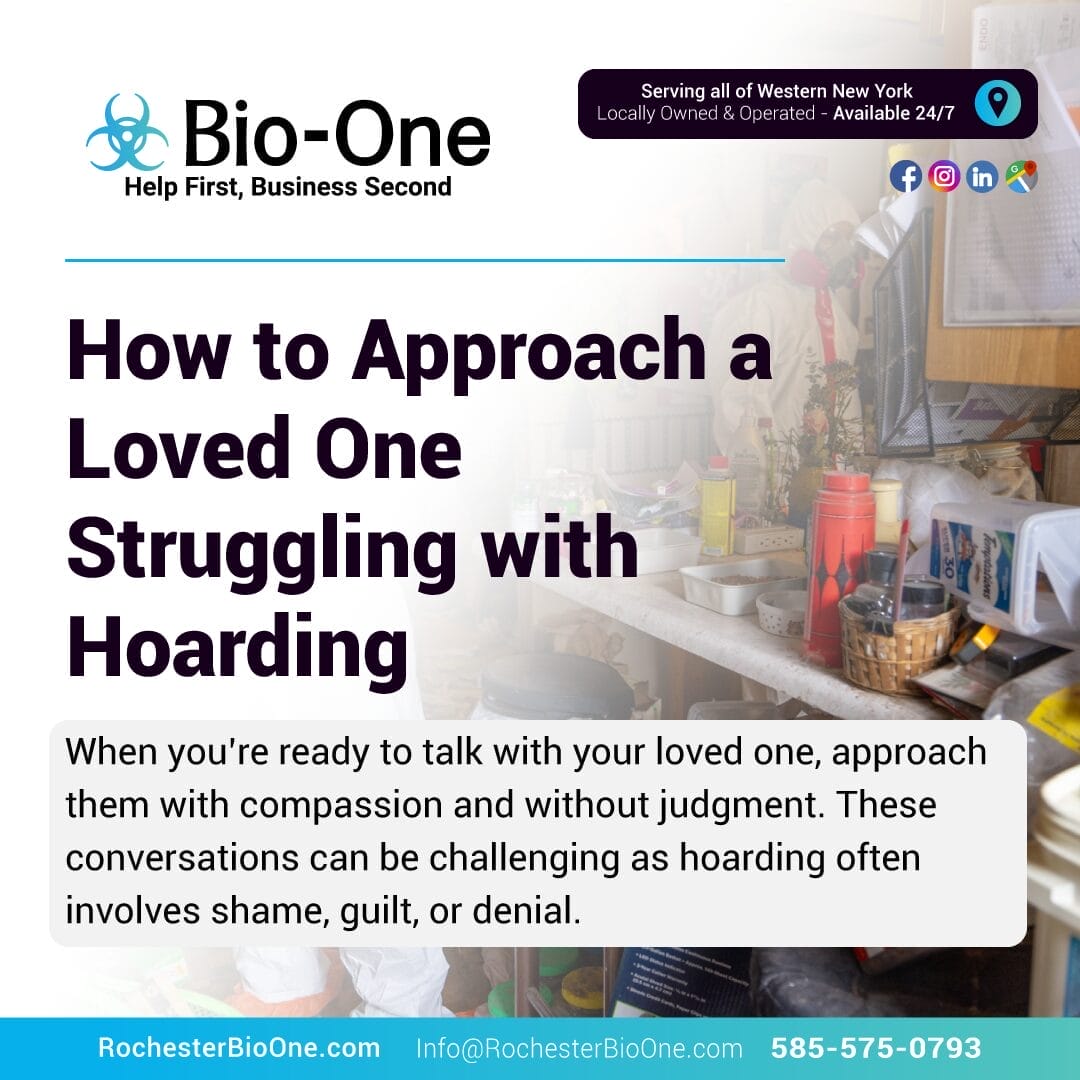
If you have a loved one who may be struggling with hoarding, you’ve likely experienced a mix of concern, frustration, and helplessness. Hoarding disorder is not just about collecting items; it’s a complex psychological condition that can affect a person’s health, safety, and well-being. Approaching a loved one about hoarding requires a great deal of empathy, patience, and understanding. By handling the situation thoughtfully, you can open the door to meaningful change and support their path to recovery.
Here are some compassionate and practical steps to take when approaching a loved one about hoarding.
Before starting a conversation, it’s important to recognize the signs of hoarding so you can approach the issue with an informed perspective. Some common indications include:
Understanding these signs helps build a foundation of empathy, which is key when broaching the topic.
When you’re ready to talk with your loved one, approach them with compassion and without judgment. These conversations can be challenging as hoarding often involves shame, guilt, or denial. Here are some tips to ensure a constructive discussion:
Remember, the goal of this conversation is not to force immediate change but to foster trust and open communication.
Hoarding disorder is often tied to deeper emotional struggles such as anxiety, depression, trauma, or grief. For many people, their possessions are connected to memories, identity, or a sense of security. Understanding these underlying factors can help you approach the issue with sensitivity.
When supporting someone struggling with hoarding, it’s important to strike a balance between helping and setting healthy boundaries. Here’s how:
Hoarding often requires the expertise of professionals to address both the emotional and physical aspects of the disorder. This may include:
Professional cleanup services can be particularly effective in tackling the overwhelming physical challenges of hoarding, while leaving emotional and relational issues to the care of therapists and family.
Helping a loved one struggling with hoarding is never easy, but your compassion and support can make all the difference. By recognizing the signs, starting the conversation with care, and leaning on professional resources, you can empower them to take steps toward a safer, healthier life.
At Bio-One of Rochester, we understand the challenges families face when dealing with hoarding. Our team provides discreet, non-judgmental cleanup services tailored to your loved one’s needs. If you’re ready to take the next step, reach out to us today. Together, we can pave the way for recovery and restore safe, livable spaces.
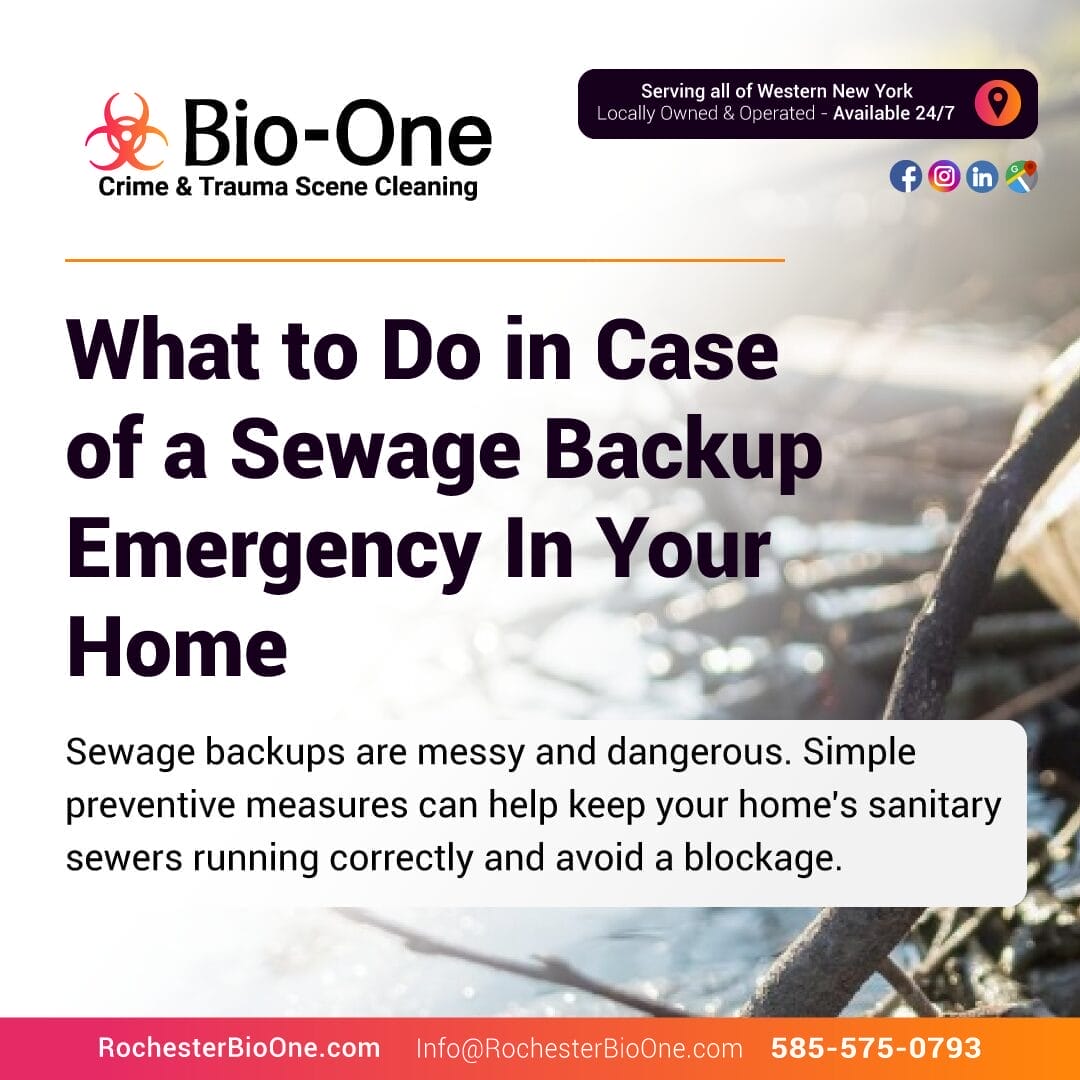
Sewage backups can occur in residential and commercial properties at any time. They are caused by clogged toilets, sink drains, and sewer lines. When sewage backs up into homes or businesses, it can cause extensive damage to the property and create a biohazardous situation that can pose a serious health risk to humans and animals.
If you have a sewage backup, you should first call a professional cleanup and restoration company like Bio-One of Rochester. We are experts in dealing with sewage backups and will work quickly to get your life back to normal. We will assess the damage, clean up the affected areas, and restore the property to its pre-accident condition.
Sewage backups are water damage that occurs when sewage or other contaminated water enters your home or business. Heavy rains, clogged sewer lines, or faulty sump pumps are the common problems with sanitary sewers.
If you have a sewage backup, it is important to act quickly and safely. First, try to identify the source of the problem and stop it if possible. If the sewage is coming from a clogged toilet, for example, flush the bathroom toilet several times to see if that clears the blockage. If the backup is coming from the drain line, turn off the water to the affected area.
Once you have stopped the source of the sewer backup, it is important to start cleanup immediately. Sewer backups can cause extensive damage to your home or business, so it is important to call in professional help as soon as possible.
Routine maintenance is the key to keeping your sanitary sewer running correctly.
Have your septic tank pumped every three to five years. Pumping removes the sludge and scum from the bottom of the tank that, if left untreated, can clog your drain field.
Get rid of tree roots. Tree roots are the number one cause of sewer line cracks, and they can grow into and through cracks in your pipes, causing blockages. If you have trees on your property, have the root zone treated with an herbicide every few years to keep roots from growing into your sewer lines.
Install a backwater valve. A backwater valve is a one-way valve that allows sewage to flow out of your home but not back in. A backwater valve can prevent backups in homes or businesses if you live in an area prone to flooding.
Sewage backups are messy and dangerous. Simple preventive measures can help keep your home's sanitary sewers running correctly and avoid a blockage. If you experience a sewage backup, call Bio-One for professional sewage backup cleanup services.
Bio-One is always ready to react to unanticipated events like death, major accidents, and hazardous situations. In the following areas of New York we provide cleaning and restoration services:
Bio-One is the finest choice for assisting victims and their families if a suicide, homicide, unattended death, crime scene, or traumatic situation occurs. In addition to emergency services, Bio-One, a locally-owned company, also offers biohazard cleanup services for commercial and residential properties.
We understand that biohazardous material can be a great source of stress for property owners, so we work quickly and efficiently to minimize the disruption it causes.
We collaborate with local law enforcement, neighborhoods, emergency services personnel, victim support organizations, hoarding task forces, apartment complexes, insurance company carriers, and others to provide the best service possible.
Our sewage backup cleaning service is available for you or anyone you knows needs it. We have the expertise and equipment to remove and safely dispose of any clutter, debris, and garbage from your home or office. Give us a call at 585-575-0793. Bio-One is here for you!

Unpleasant odors can disrupt your peace of mind, affect the comfort of your home, and even pose health risks. While some smells can be resolved with routine household cleaning, others require expert intervention. How do you know when it’s time to call a professional odor removal service like Bio-One of Rochester? Below, we’ll explore the top signs that professional expertise is necessary and how our team can help restore your home to a clean, odor-free environment.
One of the most obvious signs you need professional help is when odors persist no matter how often, or thoroughly, you clean. This often happens when smells are trapped in porous materials like carpets, upholstery, or walls. Common culprits include pet odors, mold, and smoke, all of which tend to seep into surfaces and resist DIY cleaning methods. Professional odor removal services use specialized equipment and techniques to tackle these deeply embedded smells, eliminating them at the source.
If certain smells are making you or your family members feel unwell, it’s a sign that something deeper might be wrong. Strong or foul odors caused by mold, decaying organic matter, or chemicals can trigger respiratory issues, allergies, headaches, nausea, and more. These health risks highlight the importance of addressing the underlying cause, which often requires professional interventions equipped to handle hazardous materials.
Sometimes, you can smell something unpleasant but can’t quite figure out where it’s coming from. This is often the case with biohazards like decaying organic material, rodent infestations, or hidden mold growth. Without locating the source, removing the odor completely is impossible. Bio-One of Rochester’s trained professionals have the expertise and tools to identify and target the root cause—even when it’s well-hidden—to ensure thorough elimination.
Foul odors often come accompanied by property damage. For instance, water damage from leaks can lead to musty, moldy odors, while pet urine can stain floors and damage wooden surfaces. These scenarios not only affect the smell in your home but also compromise its integrity and value. Professionals like Bio-One of Rochester don’t just remove odors; we assess the total scope of the problem and follow a comprehensive cleaning approach to restore your property.
If the unpleasant smell stems from a biohazard situation, such as decomposition, trauma, rodent infestations, or sewage backups, it’s critical to get professional help immediately. These situations aren’t just about the smell; they also pose serious health risks to anyone exposed. At Bio-One of Rochester, we’re trained to safely and discreetly handle these scenarios, ensuring your property is decontaminated and safe for everyone.
At Bio-One of Rochester, we understand that addressing severe odors can be both overwhelming and emotional. That’s why our team approaches every situation with compassion, professionalism, and the utmost discretion. We use industry-leading technologies and proven methods to completely remove odors and restore your space to its original condition. Whether you’re dealing with a lingering smell, a biohazard situation, or a hidden issue, we’re here to help.
If your home, workplace, or property is struggling with persistent odors, don’t hesitate to reach out for expert support.
Bio-One is always ready to react to unanticipated events like death, major accidents, and hazardous situations. In the following areas of New York we provide cleaning and restoration services:
Bio-One is the finest choice for assisting victims and their families if a suicide, homicide, unattended death, crime scene, or traumatic situation occurs. In addition to emergency services, Bio-One, a locally-owned company, also offers biohazard cleanup services for commercial and residential properties.
We understand that biohazardous material can be a great source of stress for property owners, so we work quickly and efficiently to minimize the disruption it causes.
We collaborate with local law enforcement, neighborhoods, emergency services personnel, victim support organizations, hoarding task forces, apartment complexes, insurance company carriers, and others to provide the best service possible.
We have the expertise and equipment to remove and safely dispose of any clutter, debris, and garbage from your home or office. Give us a call at 585-575-0793. Bio-One is here for you!
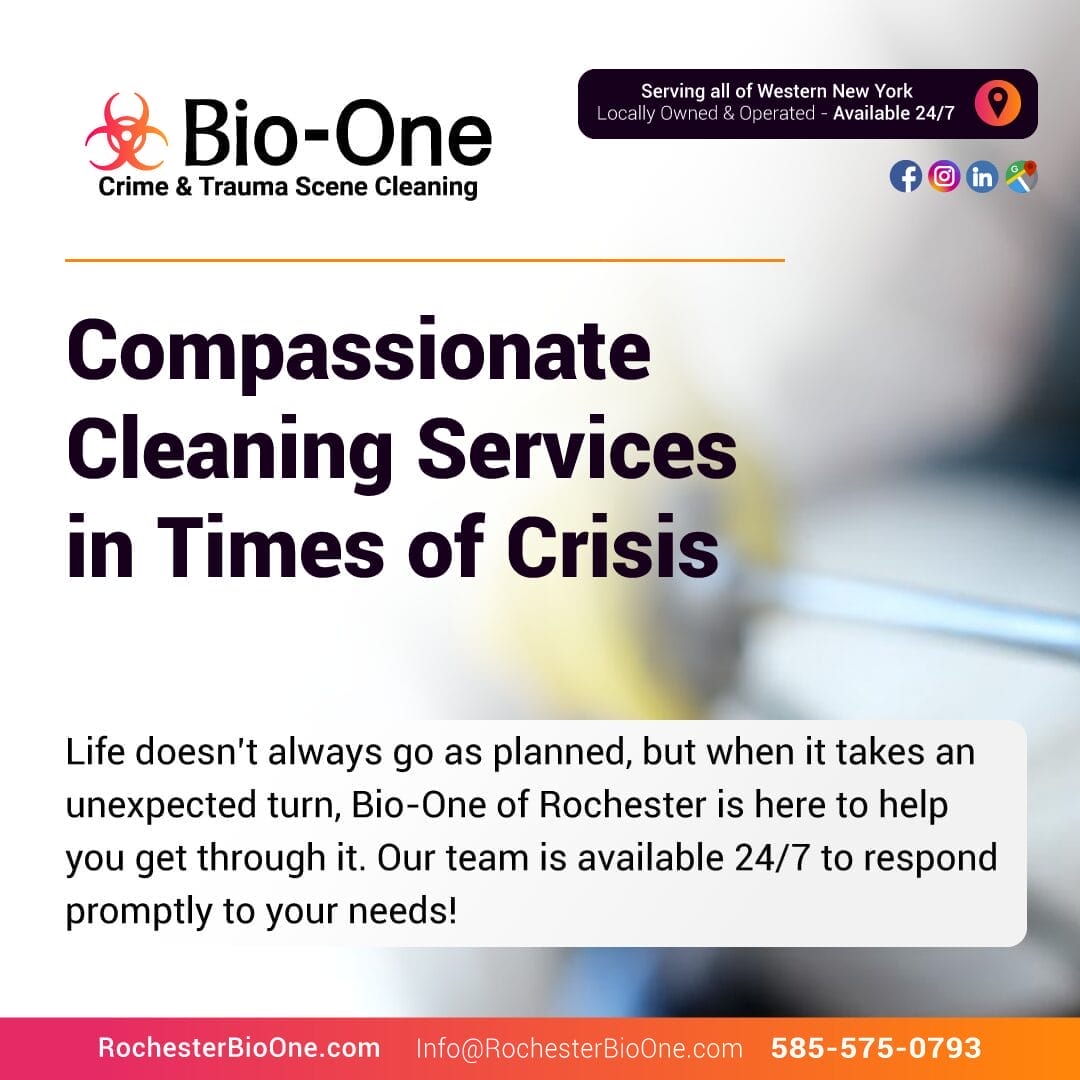
During challenging times, finding someone who truly understands the depth of your situation can make all the difference. At Bio-One of Rochester, we specialize in assisting individuals, families, and first responders during moments of crisis. Our team is known for our professional approach, compassionate care, and round-the-clock availability to ensure that you are supported every step of the way.
If you or someone you know is navigating extreme circumstances requiring specialized cleaning services, we’re here to help. This blog highlights our commitment, our services, and the reasons why trusting Bio-One of Rochester is a step toward restoring safety and peace of mind in difficult times.
First responders face unimaginable situations daily—scenes that require not only mental strength but also a partner who can seamlessly step in and take care of the aftermath. Families and individuals can also encounter traumatic and overwhelming life events that leave them unsure of what to do next.
At Bio-One of Rochester, we stand ready to assist both groups with our empathetic and discreet services. Whether it's helping families reclaim their homes or supporting first responders by restoring spaces back to safety, we take immense pride in being a trusted partner in our community.
What sets us apart is our ability to handle a wide variety of sensitive situations with precision, care, and confidentiality. Below are some of our most requested services, designed with your unique needs in mind.
After a traumatic event, the last thing anyone needs to worry about is cleaning up the aftermath. We specialize in handling sensitive situations with the utmost respect and confidentiality. Our certified team ensures that every space is fully restored to safety, helping to remove the burden from those already under emotional stress.
Handling an unattended death or decomposition is an overwhelming experience for families. Our team steps in with both professionalism and compassion, ensuring that the area is meticulously restored. We use advanced cleaning techniques and equipment to eliminate potential biohazards, offering families peace of mind.
Our team goes beyond "deep cleaning." We specialize in full-scale sanitization through hospital-grade solutions and equipment. Whether cleaning a business, church, or residence, you can rest assured that our team works to eliminate risks to health and safety in a meticulous manner.
Some events leave behind more than physical residue—persistent unpleasant odors can linger long after the visible mess has been cleaned. Our expert odor-neutralization process targets airborne particles, ensuring the space feels fresh and livable again.
Hoarding situations can feel overwhelming for families and loved ones. Whether addressing years of clutter or creating a safe living environment for someone struggling with a hoarding disorder, our team handles each project with patience, confidentiality, and care. Every step we take is on your timeline, ensuring the entire process feels supportive instead of judgmental.
Our team is certified in advanced bio-recovery techniques, ensuring the highest level of safety and efficiency in every service we provide. Whether the task is large or small, we take every measure to ensure thoroughness and compliance with industry standards.
We understand that our clients come to us during what may be the most difficult time of their lives. Compassion is at the core of everything we do. Our priority is to make this process as seamless and supportive as possible.
Emergencies don’t wait—and neither do we. Our team is available 24/7 to respond promptly to your needs. No matter the time or day, you can count on us to be there when you need us most.
Sensitive situations demand discretion. We take your privacy seriously and operate with utmost respect, ensuring that your information and situation are handled with complete confidentiality.
We live and work right here in the Rochester community, making us especially invested in caring for our neighbors. You’re not just a client—you’re family. Our support for first responders and families is part of our commitment to strengthening the community we call home.
The moment you reach out, our compassionate team springs into action. We’ll listen to your situation, answer any questions, and determine exactly how we can help.
Once we arrive at the location, we conduct a personalized assessment to identify the best course of action. Everything is explained clearly so you’ll always know what to expect.
With specialized equipment and a professional approach, we clean, sanitize, and restore the area to its original condition—or better. We don’t just clean; we ensure peace of mind.
Life doesn’t always go as planned, but when it takes an unexpected turn, Bio-One of Rochester is here to help you get through it. Our commitment to professionalism, compassion, and community support has made us the trusted choice for countless families and first responders alike.
If you or someone you know needs assistance, don’t hesitate to reach out. We’re available around the clock to provide the expertise and care you need, when you need it most.
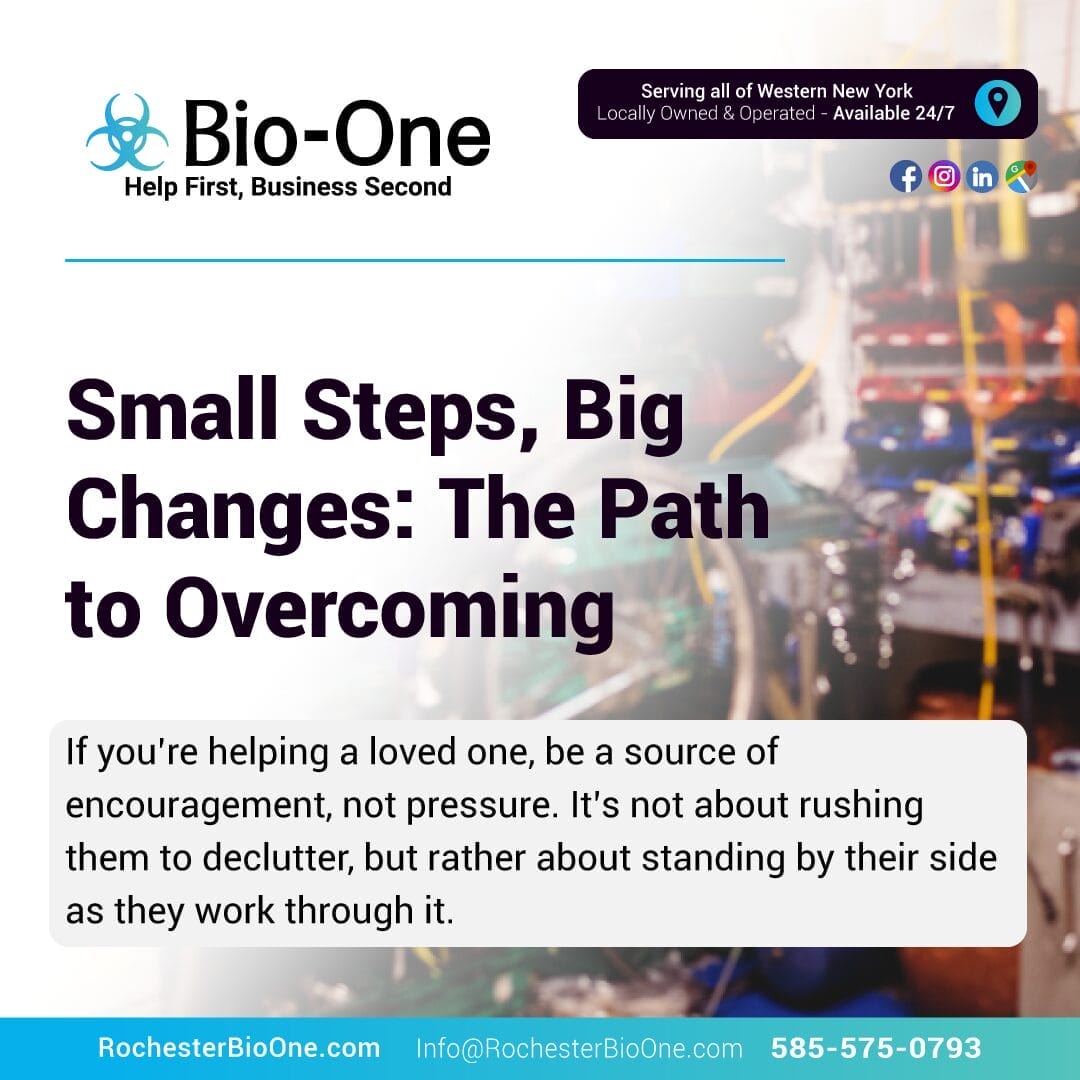
Hoarding cleanup is not just a physical task; it often comes with deep-rooted emotional hurdles that make it feel overwhelming. For individuals dealing with hoarding—or supporting a loved one through it—the process can stir up feelings like guilt, anxiety, or even fear. However, with the right approach, patience, and support, it’s possible to take meaningful steps forward. This blog will walk through practical tips to manage the emotional challenges of hoarding cleanup, offering empathy and encouragement along the way.
Hoarding is rarely just about a “mess.” Items are often tied to emotional attachments, memories, or perceived safety. Telling someone to "just throw it all away" can feel dismissive, even cruel. A sensitive approach is vital—whether you’re helping a loved one or embarking on your own cleanup.
Begin by acknowledging the emotions involved. If you’re helping someone else, listen with patience and without judgment. Recognize that they might feel fear of losing cherished memories or a sense of security tied to their belongings. Respect their attachment to items and assure them that you’re there to support, not to judge.
For those tackling their own hoarding habits, it’s important to practice self-compassion. Remind yourself that needing help doesn’t make you weak or inadequate—it makes you human.
Guilt goes hand in hand with hoarding—whether it’s guilt for letting things accumulate, guilt for needing help, or guilt for parting with items. One way to manage this is by reframing your perspective.
Instead of focusing on what you’re losing, think about what you’re gaining. Decluttering creates space—physically, emotionally, and even socially. Cleaning up might mean more time with loved ones, a safer home environment, or less mental stress from your surroundings.
If you feel guilty discarding items that seem valuable, consider giving them a second life. You could donate to charities or give items to someone who can use them. Knowing that your belongings are helping others can ease the emotional burden of letting go.
Decluttering an entire space can feel impossible if you focus on the big picture. The key is taking it one step at a time. Break the overall cleanup into smaller, manageable tasks.
Start with just one area—like a single drawer, shelf, or corner. Small victories can build momentum. Celebrate the progress you make, no matter how small it feels. Each item sorted, kept, donated, or discarded is a step toward your goal.
A strategy known as the “Four-Box Method” can be helpful. Label four boxes as “Keep,” “Donate,” “Trash,” and “Not Sure.” This approach makes decisions more concrete and manageable. Items in the “Not Sure” box can be revisited later, giving you more time to process emotionally difficult choices.
It’s normal for decluttering to bring on feelings of anxiety. You might worry about making the “wrong” decision or feel overwhelmed at the thought of losing control.
When anxiety strikes, take a moment to pause. Step away for a short break and practice deep breathing to ground yourself. Breathing exercises like inhaling for a count of four, holding for four, and exhaling for four can help calm your mind.
Creating a checklist can also help ease anxiety. Breaking tasks into small, manageable actions can make the process feel more structured and less chaotic. Checking off completed tasks gives a sense of accomplishment and progress, even if the steps are tiny.
You don’t have to go through this alone. Whether it’s family, friends, or professionals, having a support system can make a world of difference.
If you’re helping a loved one, be a source of encouragement, not pressure. It’s not about rushing them to declutter, but rather about standing by their side as they work through it. Sometimes the best support you can offer is simply being present and available.
Professional support can be invaluable, too. Professional organizers, therapists, or specialists in hoarding disorders can offer expert guidance. Therapists, in particular, can help address underlying emotional triggers for hoarding, creating a foundation for long-term change.
Support groups—whether in person or online—provide a safe space to share experiences and gain encouragement from others who understand the struggle.
Self-care is essential when navigating the emotional toll of hoarding cleanup. If you’ve spent hours making tough decisions about your belongings or supporting a loved one, give yourself permission to rest.
Set aside time for activities that relax and rejuvenate you. Whether it’s reading, meditating, taking a walk, or simply sitting quietly for a while, self-care helps you recharge.
For those helping someone else, remember to maintain your own boundaries. While empathy and understanding are vital, burnout can happen if you neglect your own emotional needs.
Progress is progress, no matter how small it might seem. Every cleared space, every tough decision made, and every bag donated deserves recognition. Celebrate what you’ve achieved, whether it’s finishing an entire room or even just sorting through one box.
Reward yourself for milestones, too. It could be as simple as a nice meal, a favorite TV show, or spending time with loved ones in your decluttered space. Positive reinforcement is a powerful motivator and reminds you of why you’re taking these steps.
Hoarding cleanup is an emotional process, but it’s also an opportunity for growth and transformation. By approaching it with sensitivity, managing feelings of guilt and anxiety, and taking small steps, you can make meaningful progress. Remember to lean on your support system, care for yourself along the way, and celebrate every win—even the tiny ones.
You don’t have to overcome these challenges all at once. From organizing and removing clutter to thoroughly cleaning your space, we offer a comprehensive approach tailored to your unique needs. We emphasize discretion, respect, and empathy, ensuring that you feel comfortable and in control throughout the process. Contact us today to learn more about our hoarding cleanup services and how we can create a plan that works for you!
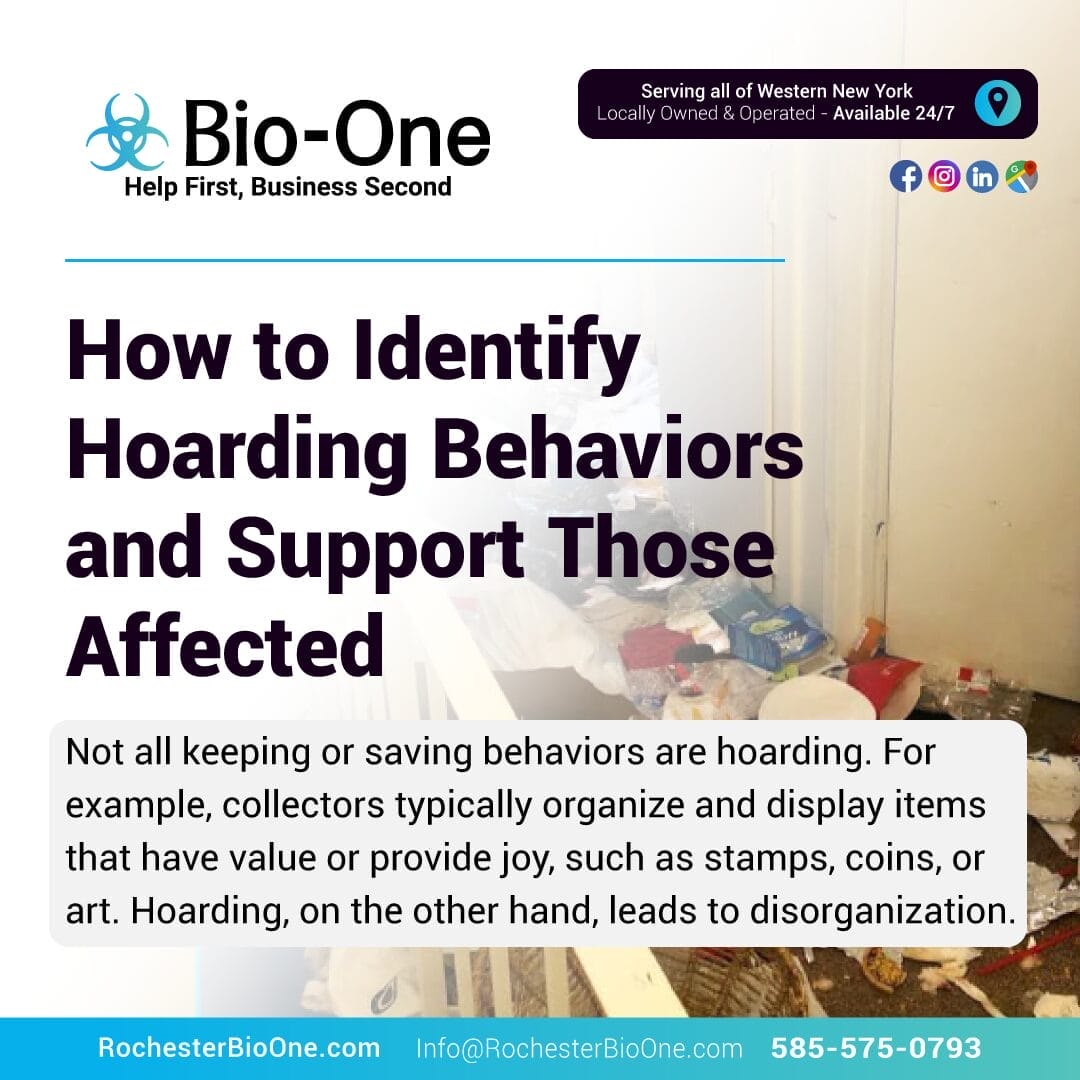
Hoarding is often misunderstood. On the surface, it may seem like someone is merely collecting items or keeping too many possessions for sentimental reasons. However, hoarding is a complex behavior that can deeply affect individuals and their loved ones emotionally, mentally, and physically. This article will take you through the key signs of hoarding, clarify the difference between collecting and hoarding, and provide resources on how to approach this behavior constructively.
Hoarding is not just about clutter or disorganization—it’s a behavioral pattern where an individual accumulates excessive amounts of possessions and experiences difficulty parting with them, regardless of their actual value. Hoarding becomes problematic when it interferes with daily living, safety, and mental wellness. It is officially recognized as a disorder in the Diagnostic and Statistical Manual of Mental Disorders (DSM-5) under Obsessive-Compulsive and Related Disorders.
Not all keeping or saving behaviors are hoarding. For example, collectors typically organize and display items that have value or provide joy, such as stamps, coins, or art. Hoarding, on the other hand, leads to disorganization, overcrowded living spaces, and often distress or shame in showing their environment to others.
Key Differentiators between Collecting and Hoarding:
It's important to recognize hoarding behaviors early to provide the right support. Here are some hallmark signs to look out for.
One of the most prominent behaviors is the inability to throw away possessions, regardless of their usefulness or condition. Even items like old magazines, broken appliances, or empty containers can feel essential to the individual.
Why this happens: Individuals with hoarding behaviors often feel intense anxiety or fear at the thought of disposing of items. Reasons may include emotional attachment, a fear of losing something important, or the belief that the item might be useful someday.
Hoarding typically involves bringing in more possessions than the individual can reasonably use or store. This can include shopping sprees, collecting free items, or bringing in things from the street.
Signs to look out for:
When hoarding behaviors become severe, clutter often spreads to the point where it blocks living areas and makes spaces unusable. For example, a kitchen may no longer function due to piles of items on the counters and stove, or a bedroom bed may be covered with so many possessions that it's no longer usable for sleeping.
Questions to ask:
Hoarding behavior often stems from intense emotional struggles. Many individuals feel embarrassed about their living environment and may avoid inviting others into their homes.
Common emotional signs include:
Overcrowded spaces can lead to serious health and safety issues. For instance, hoarding can increase the risk of falls, create fire hazards, and lead to unsanitary living conditions that may attract pests or mold.
Examples of physical risks from hoarding include:
While hoarding behaviors can seem irrational from the outside, they are often connected to deep emotional needs and past experiences.
Hoarding may stem from underlying mental health conditions such as anxiety, depression, or trauma. For some, acquiring and keeping items provides a sense of control or comfort in response to feelings of chaos or loss.
Common emotional triggers include:
Research indicates that hoarding may also have biological or neurological components. Studies show that brain areas involved in decision-making and emotional regulation may function differently in individuals who hoard.
Approaching someone about their hoarding can be a sensitive matter. It’s crucial to communicate without judgment and provide support rather than criticism.
Hoarding behaviors are deeply tied to emotional and psychological struggles. Provide a listening ear and acknowledge the difficulty the person is experiencing.
What to say:
Instead of emphasizing the mess, focus on safety and health concerns. This can help the person feel less defensive and more open to discussing their behavior.
Hoarding is a serious condition that often requires the help of qualified professionals. Mental health treatments like cognitive-behavioral therapy (CBT) have been shown to help individuals manage their hoarding behaviors.
Helpful Resources
Large-scale cleanup attempts can overwhelm individuals who hoard. Instead, focus on creating small goals like clearing one area or discarding one type of item.
Identifying hoarding behaviors is the first step toward addressing a challenge that can feel insurmountable. Whether you're a mental health professional aiming to provide effective treatment, a family member wondering how to approach a loved one, or someone who recognizes these signs in yourself, know that there are solutions and compassionate resources available.
Remember, progress takes time and patience. Tackling hoarding requires support, understanding, and professional guidance to overcome the emotional roots of these behaviors and build a safer, healthier life.
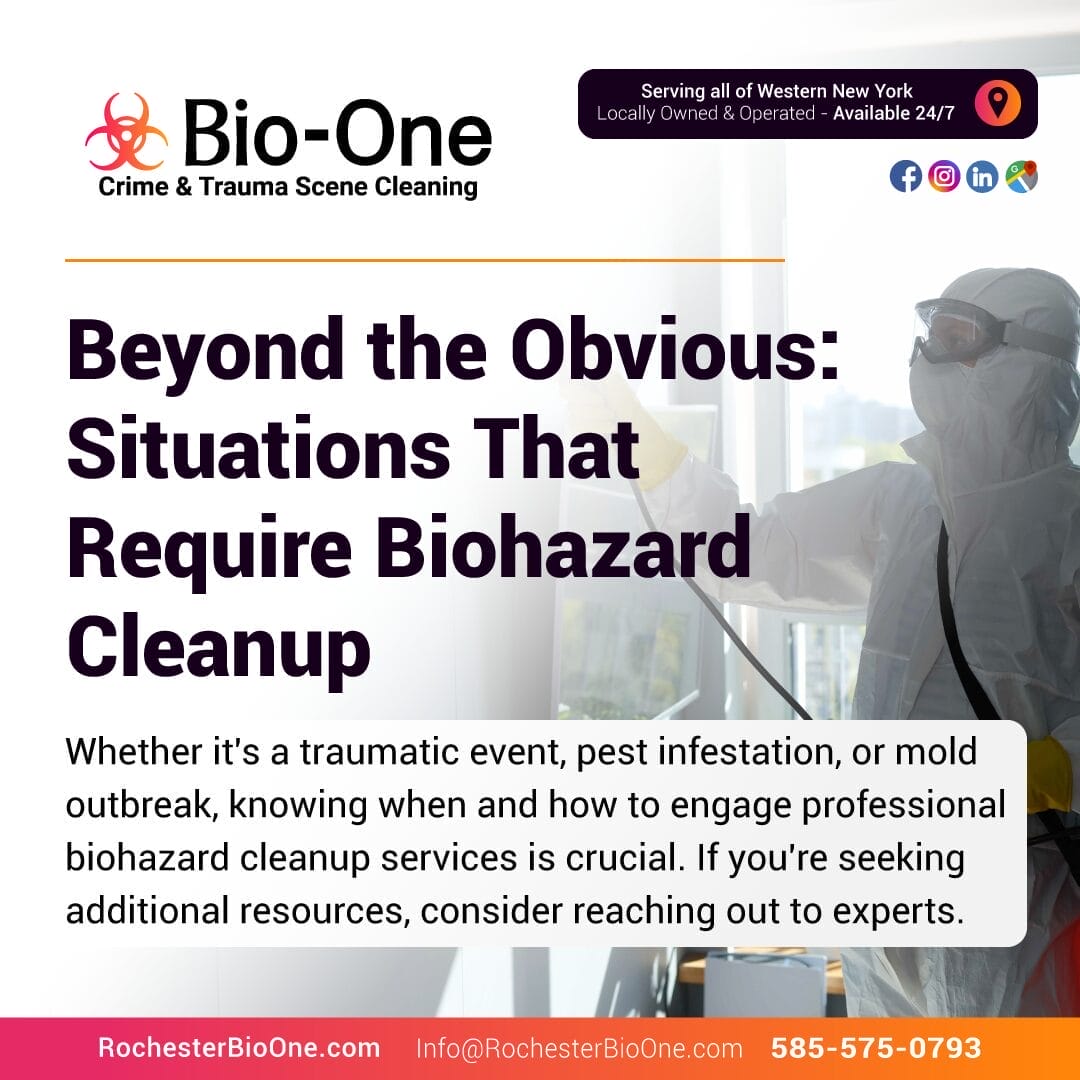
When most of us think about biohazard cleanup, the first images that pop into our heads are usually crime scenes or industrial accidents. However, the reality is that unexpected biohazard situations can arise in unexpected places and circumstances. Whether you're a homeowner, property manager, or health professional, understanding these scenarios is essential for your safety and the safety of those around you. Let's go through the less obvious situations that might require professional biohazard cleanup services, so you have valuable insights and practical information to manage these situations effectively.
Biohazards are biological substances that pose a threat to the health of living organisms. These include bacteria, viruses, fungi, and other microorganisms that can cause disease in humans and animals. Cleaning up this type of waste requires specialized knowledge and equipment to ensure that the contaminants are removed and disposed of safely.
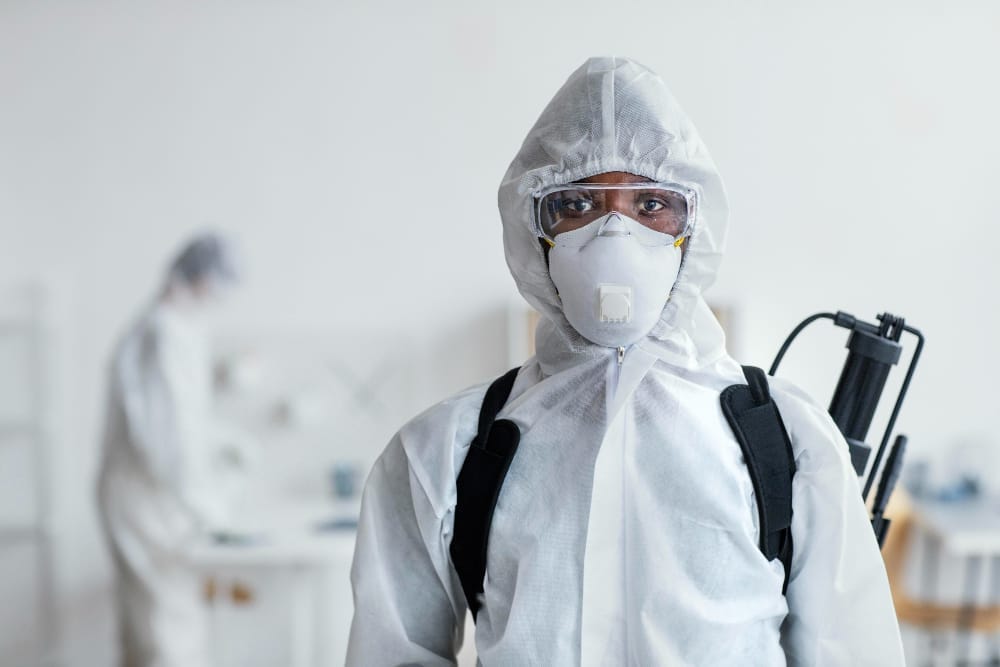
Though it might be sensationalized, incorrect handling and inadequate cleaning may result in serious health risks, including infections and disease. While some cleaning tasks can be handled with regular household cleaning supplies, biohazard situations demand specialized attention. Recognizing these situations is the first step to ensuring your environment remains safe and healthy.
One often overlooked situation that necessitates biohazard cleanup is unattended deaths. These tragic events occur when someone passes away without being discovered for an extended period. During this time, the body begins to decompose, releasing fluids and potentially harmful pathogens into the surrounding area.
Decomposition is a natural process, but it poses significant health risks if not managed properly. Pathogens from the body can spread through the air and surfaces, creating a hazardous environment.
Finding an unattended death on your property can be overwhelming, so the best thing you can do is leave the job to trained professionals, to ensure the area is made safe and habitable once more. Attempting to clean the area yourself is not recommended, as it can expose you to potentially harmful pathogens.
Hoarding can also present unexpected biohazard challenges. When people hoard, they often accumulate large amounts of items, including food waste and other organic materials. Over time, these materials can attract pests and harbor bacteria, creating a hazardous environment.
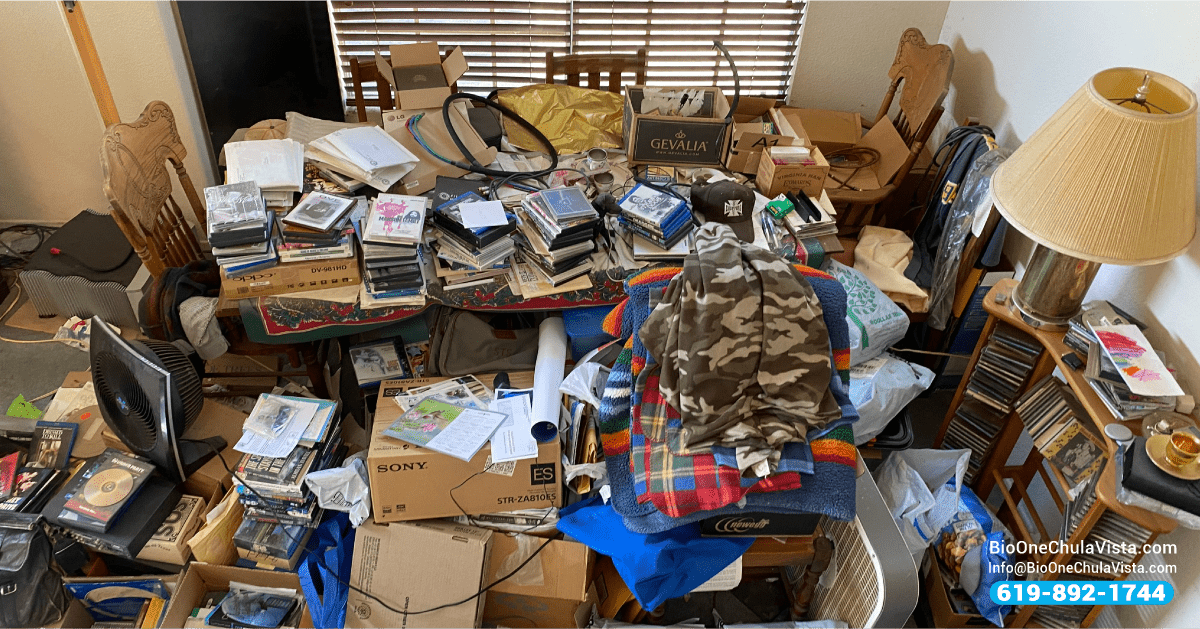
The presence of mold, decaying food, and rodent infestations are common in hoarding situations. These conditions may cause respiratory issues, skin irritations, and other health problems for anyone entering the space.
Addressing a hoarding situation requires sensitivity and care. It's important to approach the individual involved with empathy and understanding, as hoarding is often linked to mental health issues. At Bio-One of Rochester, we have a dedicated team who can not only help you with the physical aspects of a hoarding situation but also assistance in connecting with mental health resources for long-term support and recovery.
Animal infestations involving rats, bats, or birds, can lead to biohazard conditions in a property. These animals often carry diseases that can be transmitted to humans through their droppings, urine, or nesting materials. Once an infestation is identified, it's crucial to address not only the removal of the animals but also the cleanup of their waste.
Droppings from rodents and birds can harbor pathogens like hantavirus and histoplasmosis. Professional biohazard cleanup teams have the experience and equipment to safely remove these contaminants, ensuring the property is safe for human occupancy.
It's important to understand that simply removing the animals does not eliminate the biohazard risk. Thorough cleanup and disinfection are necessary to prevent the spread of disease and ensure the property is restored to a safe condition.
Sewage backups are unexpected biohazard situations that may not immediately come to mind when thinking about biohazards, but they indeed qualify. When sewage backs up into a property, it brings with it a host of harmful bacteria and viruses. Exposure to these pathogens can lead to serious health issues, including gastrointestinal illnesses and infections.
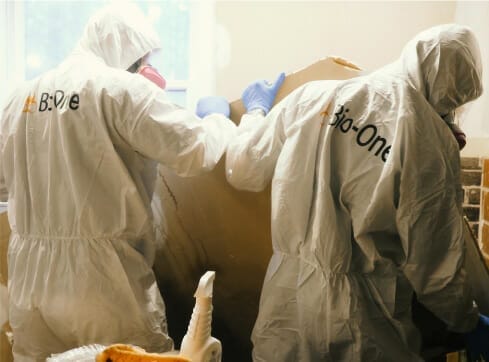
The odors associated with sewage backups are often overwhelming, but the invisible pathogens are the real danger. Professional biohazard cleanup services can quickly and effectively address the situation.
With the rise in illegal drug manufacturing, properties used as drug labs present significant biohazard challenges. The chemicals used in drug production are often toxic and can leave behind hazardous residues. These residues can permeate walls, floors, and furniture, making the environment unsafe for future occupants.
Mold infestations are a common issue in homes and properties, particularly in areas with high humidity levels. While not all molds are hazardous, certain types can produce toxins that pose a risk to human health. Mold spores can also trigger allergic reactions and respiratory issues in sensitive individuals.
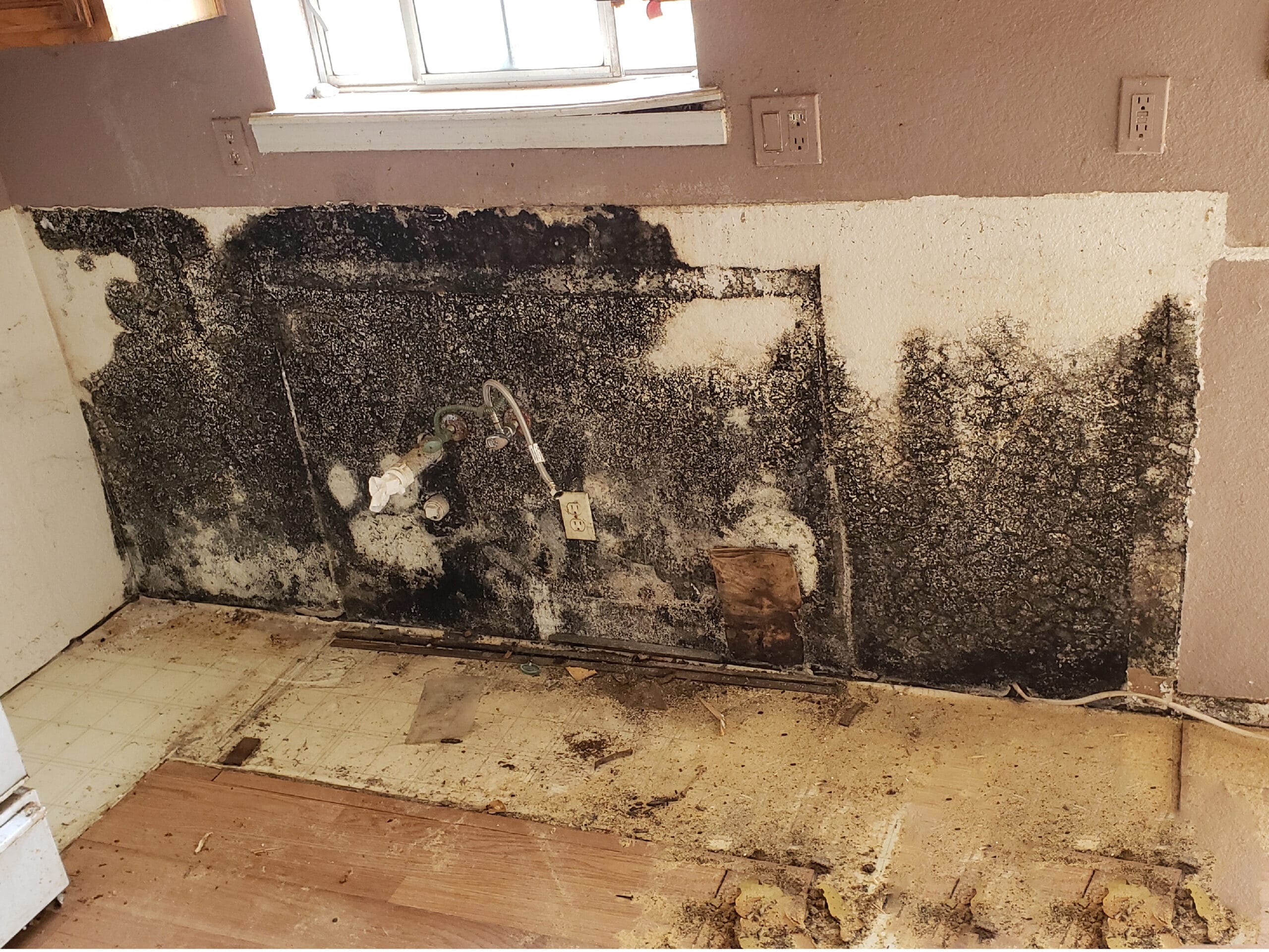
For homeowners and property managers, dealing with mold can be challenging. However, it's important to address the issue promptly to prevent further growth and potential health risks. Engaging professionals ensures that the cleanup is thorough and effective.
While crime scenes are often what we associate with biohazard cleanup, it's important to highlight this situation due to its specific requirements. Crime scene cleanup involves the removal and decontamination of blood, bodily fluids, and other potentially infectious materials. It also requires strict adherence to safety and legal protocols.
Workplace accidents, especially in industrial settings, can also require biohazard cleanup. These accidents may involve exposure to hazardous chemicals or bodily fluids, necessitating specialized cleaning procedures to ensure the safety of all employees.
While some scenarios are more apparent, others, such as unattended deaths, hoarding situations, and animal infestations, may not be immediately recognized as requiring professional intervention. By engaging professional biohazard cleanup services, you can ensure that these situations are handled with care and expertise, minimizing risk to human health and the environment.
If you're faced with unexpected biohazard situations, don't hesitate to reach out to experienced professionals at Bio-One of Rochester, who can provide the necessary support and guidance to restore your property to a safe and habitable condition. Call for a free estimate in all of Western New York!
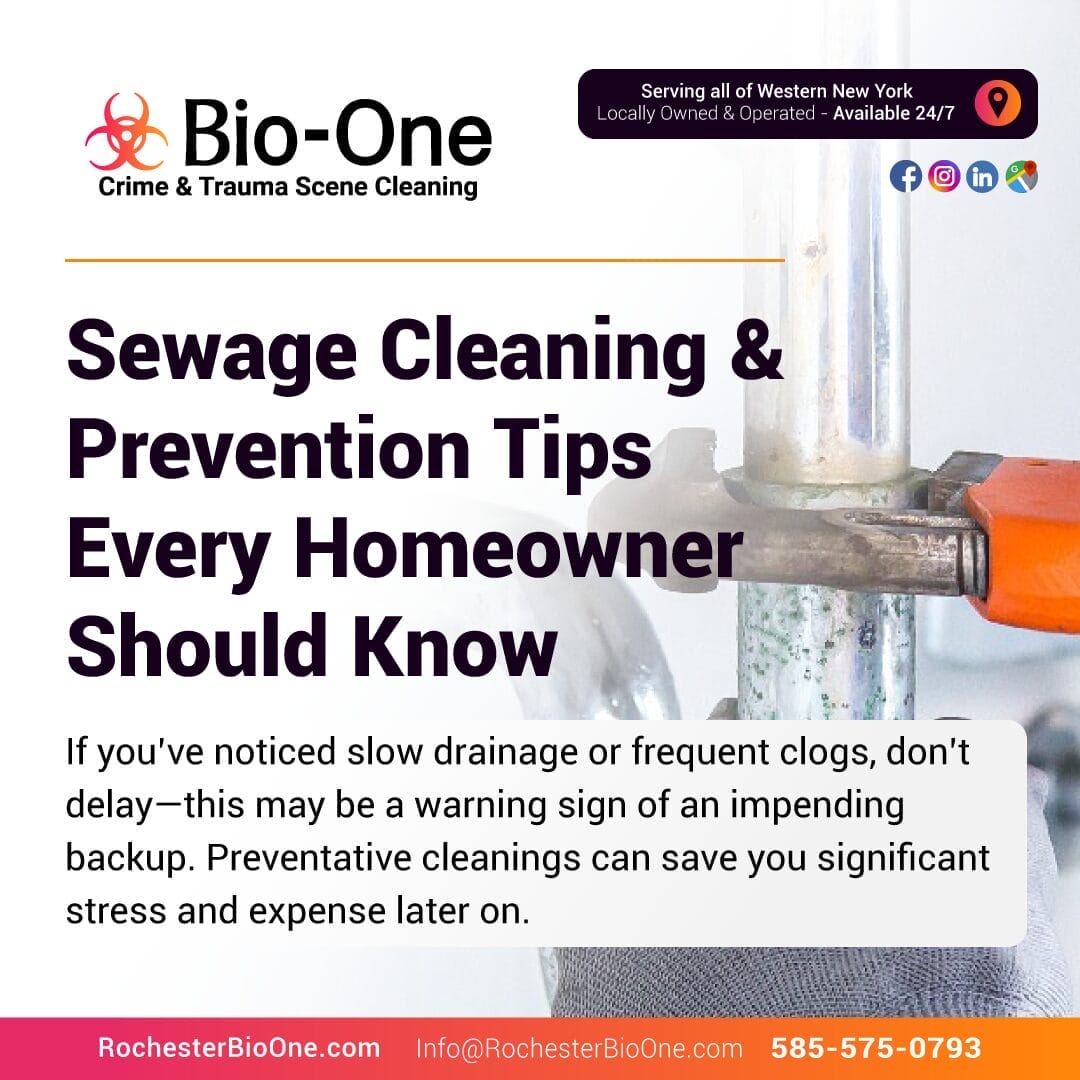
Dealing with a sewage backup can be a homeowner or property manager's worst nightmare. Not only is it unpleasant and stressful, but it can also be costly to fix and may cause extensive property damage if left unchecked. The good news? Many of these issues are entirely preventable with the right knowledge and practices.
This blog will help you understand common causes of sewer backups and offer practical tips to prevent them. By taking a proactive approach, you can protect your home and provide peace of mind.
Before we get to the tips, it’s helpful to know what typically causes sewage problems in the first place. Understanding these culprits can help you better prevent them:
Understanding these causes sets the foundation for taking informed steps to prevent problems.
It might seem obvious, but in a busy household, it's easy to forget. Toilets are designed for human waste and toilet paper—nothing else. Wipes labeled as "flushable," feminine hygiene products, and paper towels are notorious culprits for clogging sewer lines.
Tip: Place a small trash bin in each bathroom to encourage proper disposal of non-flushable items.
When grease or oil is washed down the drain, it cools and hardens inside your pipes. Over time, this sticky residue builds up and restricts water flow.
Tip: Pour leftover grease into a disposable container, such as an old jar, and throw it away in your trash instead.
Routine maintenance can catch small issues before they escalate into costly backups.
Tip: Schedule professional sewer line inspections every few years, especially if your home is older or has large trees nearby. Experts can use cameras to spot blockages or cracks early.
A backwater valve is a simple yet effective device that prevents sewage from backing up into your home. It’s a wise investment, particularly if you live in an area prone to flooding.
Tip: Ask your plumber about installing a backwater valve to provide an added layer of protection.
Trees can be a beautiful addition to your property, but their roots often spell trouble for underground sewer lines.
Tip: Avoid planting trees or bushes near your sewer lines. If you’re unsure where your sewer lines run, consult a professional service.
Clogged gutters and yard drains can lead to standing water, which might infiltrate your sewer system during storms.
Tip: Regularly clean out leaves and debris from your gutters and outdoor drains, especially before rainy seasons.
If you’ve noticed slow drainage or frequent clogs, don’t delay—this may be a warning sign of an impending backup. A professional sewage cleaning service can provide a comprehensive assessment and preventative cleaning to keep your system in top condition.
Tip: Don’t wait for an emergency. Preventative cleanings can save you significant stress and expense later on.
Even with the best preventative measures, sewage backups can still happen. If the worst occurs, stay calm and follow these steps to minimize damage and ensure your safety:
Sewage backups don’t just threaten your property—they can also disrupt the comfort and safety of your home. Thankfully, you can avoid many common issues by following these simple prevention tips. Small changes, like watching what you flush or scheduling routine maintenance, can make a big difference in the long run.
If you want professional support in keeping your sewer system healthy, don’t hesitate to reach out. Our dedicated cleaning experts are here to help with compassionate, professional service that restores peace of mind. Protect your home and your family—contact us today for a free consultation.